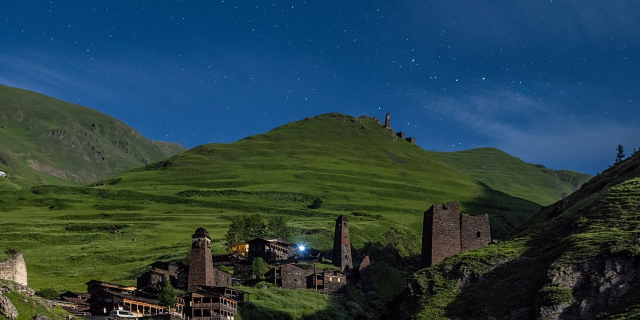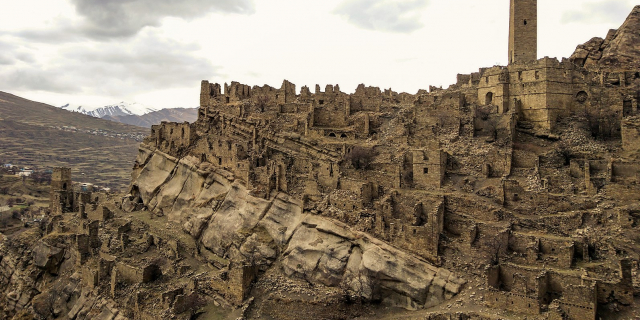თუშეთი
( Tusheti )
Tusheti (Georgian: თუშეთი, romanized: tusheti; Bats: Баца, romanized: Batsa) is a historic region in northeast Georgia. A mountainous area, it is home to the Tusheti National Park
The area is thought to have long been inhabited by the Tush, a subgroup of Georgians, which themselves divide into two groups- the Chaghma-Tush (Georgian name, used for Tush who speak the local Georgian dialect) and Tsova-Tush (Nakh-speaking Tush, better known as Bats or Batsbi). There are three major theories on the origins of the Bats (with various variations).
Ants Viires notes that there are theories involving the Bats being descended from Old Georgian tribes who adopted a Nakh language. According to this theory, the Batsbi are held to have originated from Georgian pagan tribes who fled the Christianization being implemented by the Georgian monarchy. A couple of these tribes are thought to have adopted a Nakh language as a result of contact with Nakh peoples.
Another theory is that the Bats are the remnant of a larger Nakh-speaking people. Jaimoukha speculates that they may be descended from the Kakh, a historical people living in Kakheti and Tusheti (who apparently called themselves Kabatsa).[1] However, the belief that the Kakh were originally Nakh is not widely held. The Georgian name for the Bats, the Tsova-Tush, may also (or instead) be linked to the Tsov, a historical Nakh people claimed by the Georgian historian Melikishvilli to have ruled over the Kingdom of Sophene in Urartu (called Tsobena in Georgian) who were apparently forcefully moved to the region around Erebuni, a region linked to Nakh peoples by place names and various historiography.[2][3][4] However, theories linking the Bats to Transcaucasian peoples are not universally accepted (see below).
The third theory has it that the Batsbi crossed the Greater Caucasus range from Ingusheti in the seventeenth century and eventually settled in Tusheti,[5][6] and that they are therefore a tribe of Ingush origin which was Christianized and "Georgianized" over the centuries.
King Levan of Kakheti (1520–1574) apparently granted the Bats official ownership of the lands in the Alvani Valley in exchange for their military service.[citation needed] Bats-speaking inhabitants of Tusheti are known to the local Georgians as the Tsova-Tushs, they are typically bilingual using both Georgian and their own Bats languages. Nowadays, Bats is spoken only in a village Zemo Alvani. Anthropological studies on the Tsova-Tush found them to be somewhere in between the Chechen-origin Kists and the Chaghma-Tush of the region, but significantly closer to the Chaghma-Tush.[7]
 A morning scene near Omalo
A morning scene near Omalo Moonrise over Keselo Fortress
Moonrise over Keselo Fortress
The Bats have considered themselves Georgian by nation for a long period of time, and have been speaking Georgian for a while as well.[8] They are Georgian Orthodox Christians.
Pagan Georgians from Pkhovi took refuge in the uninhabited mountains during their rebellion against Christianization implemented by the Iberian king Mirian III in the 330s.
 A small lake on the road to Tusheti
A small lake on the road to TushetiRegarding the relationship between the Nakh (Tsova) and Georgian (Chaghma) Tushians, the "Red Book", states the following:
For centuries there have been two communities next to each other in Tusheti, one speaking the Nakh language, the other Old Georgian. The general name for them is tush, according to their language either Tsova- or Chagma-Tushian. They formed one single material and intellectual unit with Old Georgian elements prevailing.
The descendants of the Old Georgian pagan tribes, whose ancestors had fled from Christianity to Tusheti, are regarded as Tushians. In the mountains some of the fugitives splintered off from other Old Georgian tribes. They were in close contact with the Nakh tribes which resulted in a new linguistic unit.[7]
After the collapse of the unified Georgian monarchy, Tusheti came under the rule of Kakhetian kings in the fifteenth century.
Many Tush families began to move southwards from Tusheti during the first half of the nineteenth century and settled in the low-lying fields of Alvan at the western end of Kakheti.
 Watchtowers of Dartlo Village in Tusheti
Watchtowers of Dartlo Village in Tusheti(Alvan had already belonged to the Tush as a wintering-ground for their flocks for centuries; it was bequeathed to them in the seventeenth century in recognition of their valuable assistance in defeating a Safavid army at the Battle of Bakhtrioni in 1659: Like a rushing stream did the Toushines make their way into the fortress, while the first rays of the rising sun were falling upon the grim old fortifications. The Tartars, half asleep, ran out into a field, but in vain for now they were met by the Pchaves and Khevsoures, who had ventured out from the gorge of Pankisse. The Tartars, surrounded on all sides, were exterminated to the last.[9])
The first to move were the Bats people following the destruction of one of their most important villages by a landslide in c.1830 and an outbreak of the plague.[10] The Tush of the Chaghma, Pirikiti and Gometsari communities followed later. Many of these families practiced a semi-nomadic way of life, the men spending the summer with the flocks of sheep high up in the mountains between April and October, and wintering their flocks in Kakheti.
During the German invasion of the Soviet Union, a minor anti-Soviet revolt took place in the area in 1942-1943, seemingly linked to the similar but more large-scale events in the neighbouring Ingushetia.































Add new comment